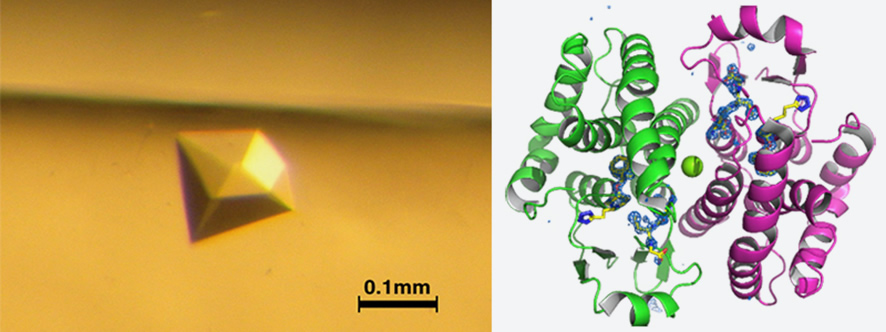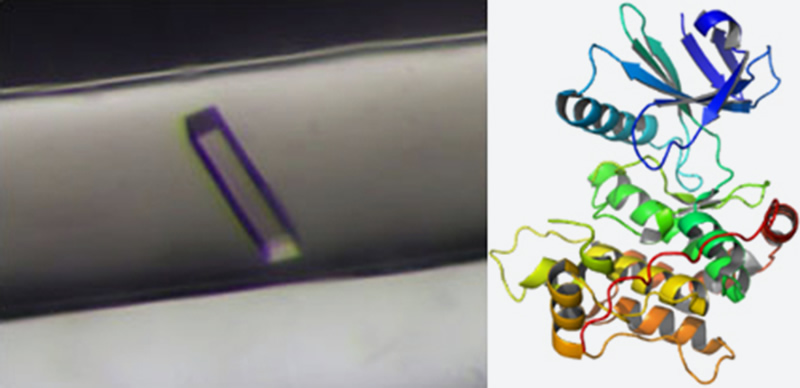Since the beginning of utilization of Russian service module, 30 space experiments were performed until 2018. Due to the long experience and technological consideration as well as verification and improvement of sampling situations and optimization of crystallization solution on th ground, many higher-quality crystals than on the ground had been acquired (see the breakdown inTable 1). Of those of which the structures were unknown at the beginning of the collaborative research with JAXA, 11 structures were determined. Also complex structure of proteins with compounds were figured out for the first time in more than 20 structures. Moreover, data collection of 12 kinds of samples was performed for the first time in the space experiment. Let us introduce the main results.
1. The protein related to the progress of Duchenne muscular dystrophy (DMD)
Yoshihiro Urade (professor at University of Tsukuba), Kosuke Aritake (professor at Daiichi University of Pharmacy)
Muscular dystrophy is a genetic muscle disease that results in increasing weakening and breakdown of skeletal muscles over time. Currently, there is no cure established for this disorder. The crystal acquired in the space experiment confirmed the detailed bonding pattern between the protein related to this disease and the drug candidate (following Figure). The research team, with the collaboration from pharmaceutical companies, utilizes the results to develop drug candidate compound effective for muscular dystrophy and assess the effectiveness and toxicity.

Crystal and structure of proteins involved in the progression of muscular dystrophy
(Source: University of Tsukuba/Daiichi Pharmaceutical University/MARUWA Foods and Biosciences, Inc /JAXA)
2. The protein related to arthritis, cardiac hypertrophy, hepatocarcinoma, etc.
Takayoshi Kinoshita (professor at Osaka Prefecture University)
Protein kinase is an important protein that conveys intracellular information, regulating complex biological functions via cell growth, differentiation, and death of cells. MAP2K7, which was successfully crystallized in the space experiment on the KIBO, is a protein kinase that regulates stress and inflammatory responses, and is an attractive drug discovery target for several diseases including arthritis, cardiac hypertrophy, and hepatocarcinoma. Up until now, the resolution of ground grown crystal was 2.1Aat most while the crystals grown at 4℃ in space diffracted up to 1.3A, providing important insights to development of medicine.

Crystal and structure of MAP2K7 (Source: Osaka Prefecture University/JAXA)
3. DPP11, an enzyme that is important for the growth of pathogen causing periodontal disease
Yasumitsu Sakamoto (Associate professor at Iwate Medical University)
Periodontal disease is known as the most widespread infectious disease among human beings caused by Porphyromonas gingivalis (Pg), and that destroys tooth-supporting tissues, leading to tooth loss. The bacteria is a Non-Fermenting Gram Negative Rod (NFGNR) that utilizes amino acids as their nutrients instead of carbohydrates.
PgDPP11 is known as an essential enzyme for bacterial growth and the pathogenicity and breaking up peptides into di-peptide. Therefore, the substances that inhibit the activity of the PgDPP11 may be candidates for antibiotics. In JAXA's Protein Crystal Growth (JAXA PCG) project, high-quality crystals of PgDPP11 were grown on board "Kibo", the Japanese experimental module of the ISS.
The space-grown crystals contributed to the determination of high-resolution structure of PgDPP11 in 2015.
Further studies of the conformations with citrate and potassium ions (or some compounds) at 1.50 A resolution determined by crystals from space experiments allowed to infer the pharmacophore around the active site required for the search and the design of potential inhibitors.
Using the pharmacophore model around the active site, various screenings and computer docking simulation studies were performed to discover potential inhibitors, 13 candidate compounds were selected from 4 million compounds.
Of these candidates, a compound SH-5 showed a significant inhibitory effect against the growth of P. gingivalis. This result is attributed to inhibition of PgDPP11 and was directly demonstrated by another microgravity experiment. PgDPP11 and SH-5 were co-crystallized on the Kibo/ISS, and it was shown clearly that the SH-5 binds to the PgDPP11 active site. The discovery of the SH-5 is a good starting point for designing of antibiotics for P. gingivalis and other NFGNRs.

Crystal and Structures of Peptide-Degrading Enzymes Important for Growth of Multidrug-Resistant Bacteria and Periodontopathic Bacteria (Source: Iwate Medical University)




